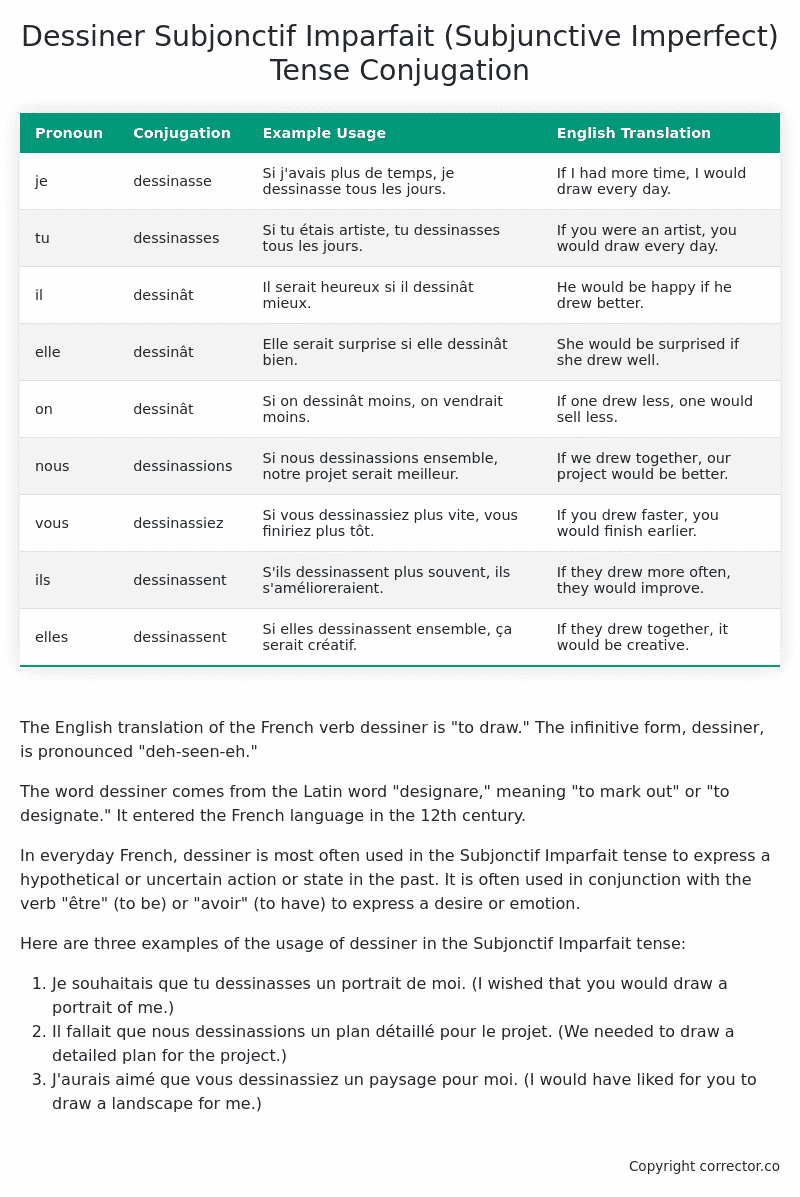Subjonctif Imparfait (Subjunctive Imperfect) Tense Conjugation of the French Verb dessiner
Introduction to the verb dessiner
The English translation of the French verb dessiner is “to draw.” The infinitive form, dessiner, is pronounced “deh-seen-eh.”
The word dessiner comes from the Latin word “designare,” meaning “to mark out” or “to designate.” It entered the French language in the 12th century.
In everyday French, dessiner is most often used in the Subjonctif Imparfait tense to express a hypothetical or uncertain action or state in the past. It is often used in conjunction with the verb “être” (to be) or “avoir” (to have) to express a desire or emotion.
Here are three examples of the usage of dessiner in the Subjonctif Imparfait tense:
- Je souhaitais que tu dessinasses un portrait de moi. (I wished that you would draw a portrait of me.)
- Il fallait que nous dessinassions un plan détaillé pour le projet. (We needed to draw a detailed plan for the project.)
- J’aurais aimé que vous dessinassiez un paysage pour moi. (I would have liked for you to draw a landscape for me.)
Table of the Subjonctif Imparfait (Subjunctive Imperfect) Tense Conjugation of dessiner
| Pronoun | Conjugation | Example Usage | English Translation |
|---|---|---|---|
| je | dessinasse | Si j’avais plus de temps, je dessinasse tous les jours. | If I had more time, I would draw every day. |
| tu | dessinasses | Si tu étais artiste, tu dessinasses tous les jours. | If you were an artist, you would draw every day. |
| il | dessinât | Il serait heureux si il dessinât mieux. | He would be happy if he drew better. |
| elle | dessinât | Elle serait surprise si elle dessinât bien. | She would be surprised if she drew well. |
| on | dessinât | Si on dessinât moins, on vendrait moins. | If one drew less, one would sell less. |
| nous | dessinassions | Si nous dessinassions ensemble, notre projet serait meilleur. | If we drew together, our project would be better. |
| vous | dessinassiez | Si vous dessinassiez plus vite, vous finiriez plus tôt. | If you drew faster, you would finish earlier. |
| ils | dessinassent | S’ils dessinassent plus souvent, ils s’amélioreraient. | If they drew more often, they would improve. |
| elles | dessinassent | Si elles dessinassent ensemble, ça serait créatif. | If they drew together, it would be creative. |
Other Conjugations for Dessiner.
Le Present (Present Tense) Conjugation of the French Verb dessiner
Imparfait (Imperfect) Tense Conjugation of the French Verb dessiner
Passé Simple (Simple Past) Tense Conjugation of the French Verb dessiner
Passé Composé (Present Perfect) Tense Conjugation of the French Verb dessiner
Futur Simple (Simple Future) Tense Conjugation of the French Verb dessiner
Futur Proche (Near Future) Tense Conjugation of the French Verb dessiner
Plus-que-parfait (Pluperfect) Tense Conjugation of the French Verb dessiner
Passé Antérieur (Past Anterior) Tense Conjugation of the French Verb dessiner
Futur Antérieur (Future Anterior) Tense Conjugation of the French Verb dessiner
Subjonctif Présent (Subjunctive Present) Tense Conjugation of the French Verb dessiner
Subjonctif Passé (Subjunctive Past) Tense Conjugation of the French Verb dessiner
Subjonctif Imparfait (Subjunctive Imperfect) Tense Conjugation of the French Verb dessiner (this article)
Subjonctif Plus-que-parfait (Subjunctive Pluperfect) Tense Conjugation of the French Verb dessiner
Conditionnel Présent (Conditional Present) Tense Conjugation of the French Verb dessiner
Conditionnel Passé (Conditional Past) Tense Conjugation of the French Verb dessiner
L’impératif Présent (Imperative Present) Tense Conjugation of the French Verb dessiner
L’infinitif Présent (Infinitive Present) Tense Conjugation of the French Verb dessiner
Struggling with French verbs or the language in general? Why not use our free French Grammar Checker – no registration required!
Get a FREE Download Study Sheet of this Conjugation 🔥
Simply right click the image below, click “save image” and get your free reference for the dessiner Subjonctif Imparfait tense conjugation!

Dessiner – About the French Subjonctif Imparfait (Subjunctive Imperfect) Tense
Formation
Common Everyday Usage Patterns
Interactions with Other Tenses
Subjonctif Présent
Indicatif Passé Composé
Conditional
Conditional Perfect
Summary
I hope you enjoyed this article on the verb dessiner. Still in a learning mood? Check out another TOTALLY random French verb conjugation!


